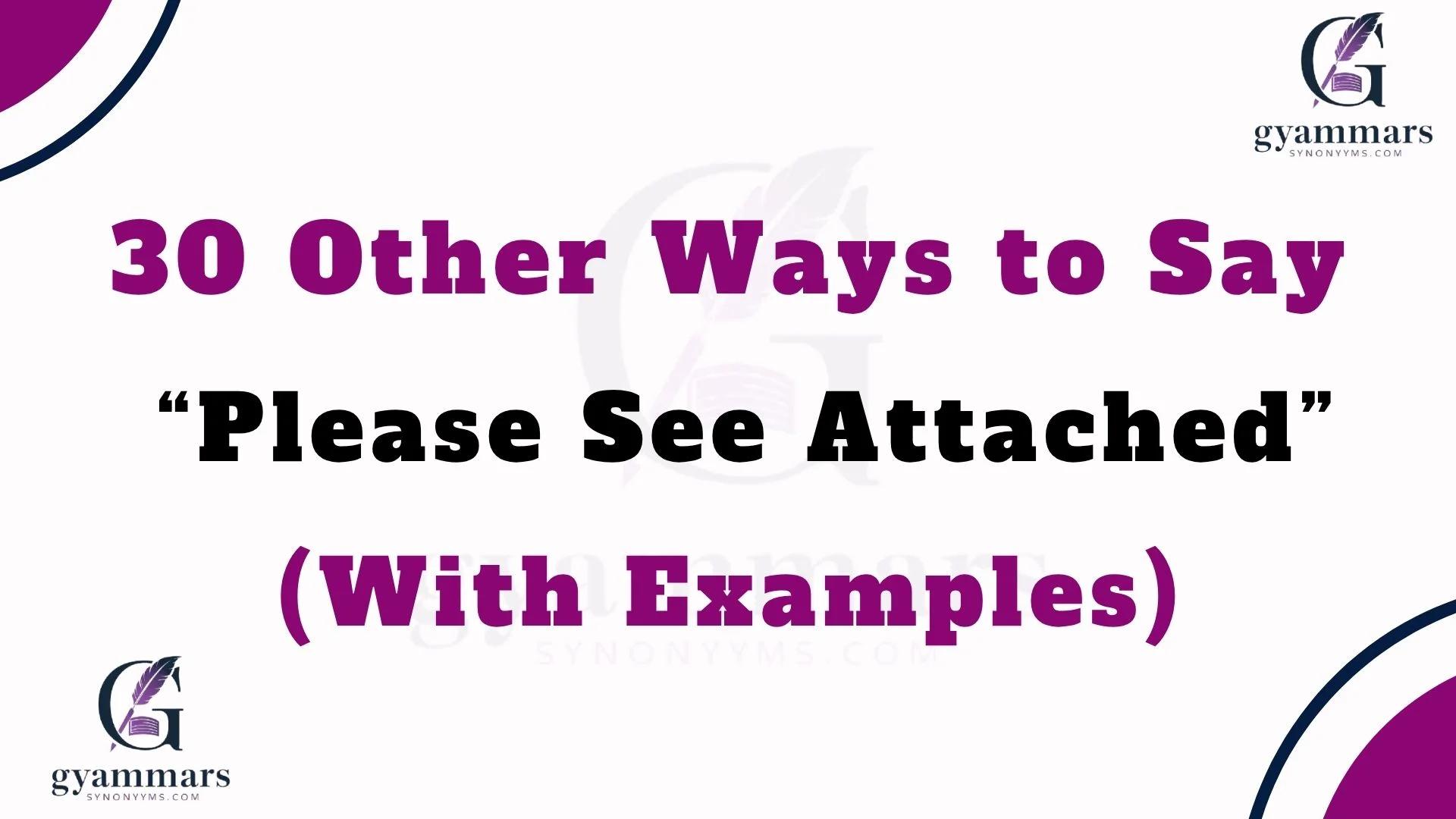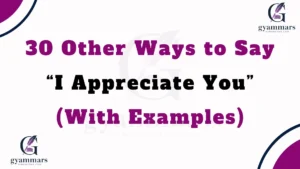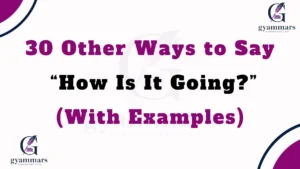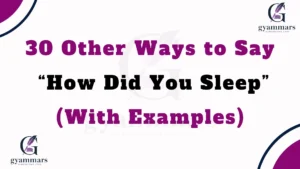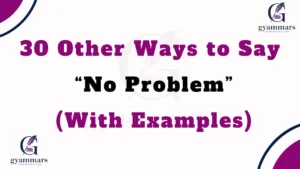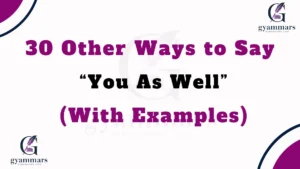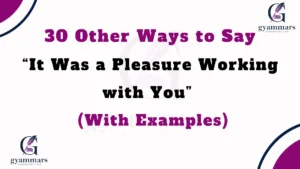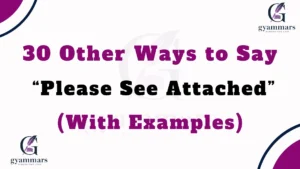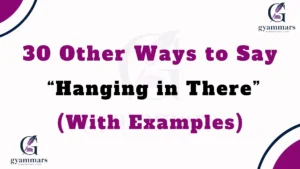Finding the right words in an email can make all the difference between sounding robotic and leaving a warm, professional impression. While “Please see attached” is clear and correct, it can sometimes feel formal or repetitive. Whether you’re writing to a client, manager, or colleague, using more thoughtful alternatives helps you sound more human, engaging, and polite.
In this guide, you’ll discover 30 other ways to say “Please see attached”, along with examples, tone suggestions, and best-use scenarios — so your messages sound professional yet personal.
Is It Professional/Polite to Say “Please See Attached”?
Yes, “Please see attached” is both professional and grammatically correct, but it can sound stiff or overused in frequent correspondence. Many professionals now prefer friendlier, more conversational alternatives that still maintain clarity and courtesy. Using varied expressions also helps you adapt your tone — formal, casual, or warm — depending on your audience.
Pros and Cons of Using “Please See Attached”
ProsConsClear and directCan sound robotic or overly formalWidely understoodLacks personal warmthProfessional toneRepetitive if used oftenEasy to writeMisses opportunity for
Finding the right words in an email helps you connect with your reader — not just inform them. While “Please see attached” is perfectly professional, it can sometimes feel a bit cold or routine. Whether you’re writing to a client, coworker, or professor, the goal is to sound warm, clear, and courteous.
Below are 30 thoughtful ways to replace “Please see attached” — each with a tone guide, real-life example, and best-use suggestion to make your messages more authentic and engaging.
What Does “Please See Attached” Mean?
The phrase “Please see attached” simply means that you’ve included a file or document in your email for the recipient to view. It’s a standard business expression that directs someone to check the attached content, like a PDF, image, invoice, or report.
Synonyms For“Please See Attached”
- I’ve attached [document name] for your review.
- Attached is [document name] for your reference.
- Please find the attached [document name].
- I’m sharing [document name] with you here.
- You’ll find [document name] attached below.
- I’ve included [document name] for you to check.
- Here’s [document name] for your convenience.
- Kindly take a look at the attached [document name].
- I’ve sent [document name] as an attachment.
- You can find the attached [document name] for details.
- Here’s the file we discussed earlier.
- I’ve added [document name] below for your review.
- You’ll see [document name] attached for your insight.
- The attached [document name] contains the requested info.
- I’ve enclosed [document name] for your attention.
- Attached, please find [document name] as requested.
- I’ve included the relevant [document name] here.
- Please review the attached [document name] when convenient.
- Here’s the [document name] you asked for.
- I’m forwarding [document name] as an attachment.
- I’ve attached [document name] to this email.
- The file [document name] is attached for your consideration.
- You’ll notice [document name] attached for easy access.
- I’ve uploaded [document name] for your review.
- You can access the attached [document name] for reference.
- Attached below is [document name] for your perusal.
- I’m including [document name] here for your use.
- The document you requested is attached here.
- Please take a moment to review the attached [document name].
- I’ve shared the [document name] you requested.
1. I’ve attached [document name] for your review.
Definition: A polite and professional phrase indicating you’ve included a file for someone to look at.
Detailed Explanation: This version feels slightly softer than “Please see attached,” and it works perfectly when you’re asking someone to review or provide feedback.
Scenario Example:
Hi Sarah, I’ve attached the project draft for your review. Please let me know if you’d like any adjustments before submission.
Best Use: Best for professional or client-related emails.
Tone: Professional, polite, and cooperative.
Additional Notes: Use this when you expect a response or review.
2. Attached is [document name] for your reference.
Definition: Directs the recipient to a file for information purposes, not necessarily feedback.
Detailed Explanation: Great for when you just want someone to keep the file on record or check details, without needing their comments.
Scenario Example:
Hello Mark, Attached is the updated price sheet for your reference.
Best Use: When sharing resources or data.
Tone: Neutral and professional.
Additional Notes: Works well in formal corporate communication.
3. Please find the attached [document name].
Definition: A traditional but still respected business phrase.
Detailed Explanation: Often used in formal settings, especially when sending contracts, reports, or job applications.
Scenario Example:
Dear Hiring Manager, Please find the attached resume and cover letter for your consideration.
Best Use: Formal business or job-related emails.
Tone: Formal, respectful.
Additional Notes: Common in British English and corporate environments.
4. I’m sharing [document name] with you here.
Definition: A friendly and modern alternative emphasizing connection.
Detailed Explanation: “Sharing” adds a personal, collaborative tone, making your message sound approachable.
Scenario Example:
Hi Alex, I’m sharing the presentation slides with you here for tomorrow’s meeting.
Best Use: Internal communication and team emails.
Tone: Warm, conversational.
Additional Notes: Avoid in very formal correspondence.
5. You’ll find [document name] attached below.
Definition: Politely indicates that the file is attached to the same email.
Detailed Explanation: This phrase is simple and works best when the attachment is visually obvious (like under your signature).
Scenario Example:
Hello Jamie, You’ll find the quarterly report attached below for your records.
Best Use: Routine communication with clients or colleagues.
Tone: Professional and neutral.
Additional Notes: Add clarity by naming the file if there are multiple attachments.
6. I’ve included [document name] for you to check.
Definition: Indicates the file is provided for the recipient’s review or verification.
Detailed Explanation: The word “included” feels friendly and cooperative, suggesting that you’ve thoughtfully added the file for them.
Scenario Example:
Hi Tina, I’ve included the meeting notes for you to check before we finalize.
Best Use: Collaborative or review-based conversations.
Tone: Helpful, considerate.
Additional Notes: Works well when you expect a response.
7. Here’s [document name] for your convenience.
Definition: A polite phrase used to make the recipient’s task easier or quicker.
Detailed Explanation: The phrase “for your convenience” signals thoughtfulness and care, ideal for customer-focused emails.
Scenario Example:
Dear Mr. Adams, Here’s your invoice for your convenience. Thank you for your continued trust.
Best Use: Customer service and client communication.
Tone: Courteous, warm.
Additional Notes: Great for customer-facing emails.
8. Kindly take a look at the attached [document name].
Definition: A gentle and polite request for the recipient to review the attached file.
Detailed Explanation: The word “kindly” adds a soft touch, perfect for formal yet respectful communication.
Scenario Example:
Dear Dr. Patel, Kindly take a look at the attached manuscript and share your feedback.
Best Use: Formal communication or respectful tone situations.
Tone: Polite, formal, and humble.
Additional Notes: Avoid overusing “kindly” in casual settings.
9. I’ve sent [document name] as an attachment.
Definition: Straightforward and clear.
Detailed Explanation: Works well when you simply need to inform that something is attached — no request implied.
Scenario Example:
Hi Leo, I’ve sent the signed contract as an attachment.
Best Use: Transactional or factual messages.
Tone: Neutral and efficient.
Additional Notes: Best for quick exchanges.
10. You can find the attached [document name] for details.
Definition: Guides the reader to the file for more information.
Detailed Explanation: Best for emails where the attachment contains supporting data or visuals.
Scenario Example:
Hello Emily, You can find the attached brochure for more details on our services.
Best Use: Sales, marketing, or informational contexts.
Tone: Helpful and professional.
Additional Notes: Ideal when explaining or referencing product details.
11. Here’s the file we discussed earlier.
Definition: A casual yet professional phrase referencing a previous conversation or meeting.
Detailed Explanation: It’s perfect when following up on something already mentioned — friendly, simple, and respectful.
Scenario Example:
Hi Laura, Here’s the file we discussed earlier. Let me know if it matches your expectations.
Best Use: After meetings or discussions.
Tone: Conversational and collegial.
Additional Notes: Builds continuity and shows attentiveness.
12. I’ve added [document name] below for your review.
Definition: Lets the recipient know you’ve attached a document that needs their feedback.
Detailed Explanation: The phrase feels active and engaging, showing that you’ve made an effort to organize things neatly for them.
Scenario Example:
Hey Paul, I’ve added the new layout below for your review. Appreciate your quick thoughts on this.
Best Use: Internal team communication.
Tone: Friendly, collaborative.
Additional Notes: Works well with informal teams or creative workspaces.
13. You’ll see [document name] attached for your insight.
Definition: Encourages the reader to provide input or opinion on the attached file.
Detailed Explanation: “For your insight” implies you value their perspective — a polite way to show respect.
Scenario Example:
Dear Maria, You’ll see the design draft attached for your insight. Your feedback will be greatly appreciated.
Best Use: Collaboration or feedback-oriented tasks.
Tone: Respectful and appreciative.
Additional Notes: Great for showing thoughtfulness.
14. The attached [document name] contains the requested info.
Definition: Clearly states that the file has the information the reader asked for.
Detailed Explanation: Direct and efficient — ideal for task-based exchanges.
Scenario Example:
Hello Team, The attached spreadsheet contains the requested data from last week’s meeting.
Best Use: Professional, factual communication.
Tone: Straightforward and formal.
Additional Notes: Best for business and project updates.
15. I’ve enclosed [document name] for your attention.
Definition: A formal phrase showing that the file is attached and should be noticed or prioritized.
Detailed Explanation: The word “enclosed” gives a polished, traditional feel, often used in legal, academic, or corporate communication.
Scenario Example:
Dear Board Members, I’ve enclosed the final audit report for your attention.
Best Use: Official or high-level correspondence.
Tone: Formal, polished.
Additional Notes: Works beautifully in printed or digital letters.
16. Attached, please find [document name] as requested.
Definition: A polite, professional way to say you’ve attached a file someone specifically asked for.
Detailed Explanation: Common in formal or transactional communication, it balances respect and clarity.
Scenario Example:
Dear Mr. Khan, Attached, please find the policy draft as requested.
Best Use: When fulfilling a request.
Tone: Courteous and formal.
Additional Notes: Avoid overuse in casual emails; fits legal, HR, or executive contexts.
17. I’ve included the relevant [document name] here.
Definition: Suggests that only the most important and applicable document is attached.
Detailed Explanation: It’s efficient and conveys that you’ve filtered out unnecessary files — showing consideration.
Scenario Example:
Hi Rebecca, I’ve included the relevant summary here for quick reference.
Best Use: Time-sensitive or summarized sharing.
Tone: Efficient and clear.
Additional Notes: Works great in busy work environments.
18. Please review the attached [document name] when convenient.
Definition: Politely asks the recipient to review the document at their own pace.
Detailed Explanation: The phrase “when convenient” softens the tone and shows respect for the recipient’s time.
Scenario Example:
Dear Jonathan, Please review the attached proposal when convenient and share your input.
Best Use: Feedback or approval requests.
Tone: Respectful and kind.
Additional Notes: Reflects emotional intelligence and professionalism.
19. Here’s the [document name] you asked for.
Definition: A simple, friendly follow-up for something specifically requested.
Detailed Explanation: It’s direct but with a human touch — short, warm, and courteous.
Scenario Example:
Hi Chris, Here’s the file you asked for yesterday. Let me know if you need anything else.
Best Use: Informal, task-oriented communication.
Tone: Friendly and helpful.
Additional Notes: Great for one-on-one or peer communication.
20. I’m forwarding [document name] as an attachment.
Definition: Indicates you’re sending a file received from someone else.
Detailed Explanation: Keeps clarity about where the file originated, often used in multi-person communication.
Scenario Example:
Hi Dana, I’m forwarding the updated schedule as an attachment, as shared by the design team.
Best Use: Forwarded or multi-party emails.
Tone: Clear and professional.
Additional Notes: Always clarify source for transparency.
21. I’ve attached [document name] to this email.
Definition: Straightforward and explicit — no confusion about where the file is.
Detailed Explanation: Good for reminding recipients to check attachments they might miss.
Scenario Example:
Hi Lisa, I’ve attached the photos to this email for your review.
Best Use: Everyday office communication.
Tone: Clear and direct.
Additional Notes: Add a friendly note if the file is large or important.
22. The file [document name] is attached for your consideration.
Definition: Suggests you’d like the recipient to review and think about the file’s contents.
Detailed Explanation: Ideal when you want feedback or decision-making.
Scenario Example:
Hello Dr. Allen, The file “Research_2025.pdf” is attached for your consideration.
Best Use: Academic, HR, or proposal settings.
Tone: Respectful and formal.
Additional Notes: Pairs well with “please share your thoughts.”
23. You’ll notice [document name] attached for easy access.
Definition: Highlights the convenience of the file being right there.
Detailed Explanation: It’s friendly and practical, suggesting you’re making their life easier.
Scenario Example:
Hey Kevin, You’ll notice the updated report attached for easy access.
Best Use: Team or peer communication.
Tone: Helpful and casual.
Additional Notes: Adds a nice customer-service tone.
24. I’ve uploaded [document name] for your review.
Definition: Indicates that the file is either attached or shared via link.
Detailed Explanation: Perfect for digital sharing (e.g., Drive, Dropbox, etc.).
Scenario Example:
Hi Nadia, I’ve uploaded the proposal for your review. You can also view it via the shared link.
Best Use: When using cloud attachments.
Tone: Modern, polite.
Additional Notes: Clarify where it’s uploaded to avoid confusion.
Also Read This: 30 Other Ways to Say “Hanging in There” (With Examples)
25. You can access the attached [document name] for reference.
Definition: Directs the reader to the file for information.
Detailed Explanation: Best for reference-based or informational communication.
Scenario Example:
Dear Robert, You can access the attached document for reference on our next steps.
Best Use: Reports or follow-ups.
Tone: Professional and neutral.
Additional Notes: Useful in documentation or policy sharing.
26. Attached below is [document name] for your perusal.
Definition: A polished way of saying “please read the attached document.”
Detailed Explanation: “Perusal” gives a refined, formal tone, best suited for official correspondence.
Scenario Example:
Dear Committee Members, Attached below is the annual report for your perusal.
Best Use: High-level or academic correspondence.
Tone: Formal and elegant.
Additional Notes: Great for letters, reports, or board communications.
27. I’m including [document name] here for your use.
Definition: Suggests the file is practically helpful or will be used directly by the recipient.
Detailed Explanation: Emphasizes value rather than obligation.
Scenario Example:
Hello Dana, I’m including the new format here for your use in upcoming reports.
Best Use: When providing templates or resources.
Tone: Friendly and helpful.
Additional Notes: Works well for training or support emails.
28. The document you requested is attached here.
Definition: Confirms that the requested file is attached.
Detailed Explanation: Shows attentiveness and completion of a prior request.
Scenario Example:
Hi Thomas, The document you requested is attached here. Let me know if everything looks good.
Best Use: Customer or client response.
Tone: Professional and courteous.
Additional Notes: Pairs nicely with a “thank you” note.
29. Please take a moment to review the attached [document name].
Definition: Encourages review while being polite and time-conscious.
Detailed Explanation: It’s ideal when you’re politely urging someone to prioritize the attachment.
Scenario Example:
Dear Helen, Please take a moment to review the attached summary before our call tomorrow.
Best Use: Pre-meeting or urgent reviews.
Tone: Gentle yet assertive.
Additional Notes: Balances urgency with kindness.
30. I’ve shared the [document name] you requested.
Definition: Simple and clear — shows follow-through and helpfulness.
Detailed Explanation: Indicates that the document is now accessible to the person who asked for it.
Scenario Example:
Hi Olivia, I’ve shared the user manual you requested. Hope it helps with setup!
Best Use: Customer service or support-related communication.
Tone: Friendly, professional.
Additional Notes: Perfect closing line for customer interactions.
Conclusion
Choosing the right way to say “Please see attached” can make your email feel more thoughtful, natural, and reader-friendly. By using alternatives that match your tone and relationship, you build better communication habits — ones that show respect, warmth, and clarity. Whether you’re writing to a client or colleague, the goal is simple: make your words feel human.
Frequently Asked Questions
1. Is “Please see attached” still acceptable in 2025?
Yes, it’s still widely accepted — but it’s better to vary your phrasing to sound more genuine and modern.
2. What’s the most polite way to refer to attachments?
Use phrases like “I’ve attached…” or “Attached is…” — they’re courteous and natural.
3. Should I name the file in the email?
Absolutely! Always mention the exact file name (e.g., “attached invoice.pdf”) for clarity.
4. Can I use emojis or casual language in professional emails?
Only in friendly or informal contexts — avoid them in formal or client communications.
5. What should I do if I forget to attach a file?
A quick follow-up email with a message like “Apologies — here’s the file I meant to attach earlier” works best.

“Mia Rose at Grammar Synonyms is your ultimate guide to mastering language with style and precision. Whether you’re looking to enhance your vocabulary, perfect your grammar, or discover the ideal synonym, Mia Rose offers expert resources and creative solutions to help you express yourself flawlessly. With Grammar Synonyms, unlock a world of language possibilities and elevate every piece of writing you create.
